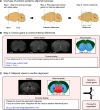SMART: An Open-Source Extension of WholeBrain for Intact Mouse Brain Registration and Segmentation
- PMID: 35396258
- PMCID: PMC9070730
- DOI: 10.1523/ENEURO.0482-21.2022
SMART: An Open-Source Extension of WholeBrain for Intact Mouse Brain Registration and Segmentation
Abstract
Mapping immediate early gene (IEG) expression across intact mouse brains allows for unbiased identification of brain-wide activity patterns underlying complex behaviors. Accurate registration of sample brains to a common anatomic reference is critical for precise assignment of IEG-positive ("active") neurons to known brain regions of interest (ROIs). While existing automated voxel-based registration methods provide a high-throughput solution, they require substantial computing power, can be difficult to implement and fail when brains are damaged or only partially imaged. Additionally, it is challenging to cross-validate these approaches or compare them to any preexisting literature based on serial coronal sectioning. Here, we present the open-source R package SMART (Semi-Manual Alignment to Reference Templates) that extends the WholeBrain R package framework to automated segmentation and semi-automated registration of intact mouse brain light-sheet fluorescence microscopy (LSFM) datasets. The SMART package was created for novice programmers and introduces a streamlined pipeline for aligning, registering, and segmenting LSFM volumetric datasets across the anterior-posterior (AP) axis, using a simple "choice game" and interactive menus. SMART provides the flexibility to register whole brains, partial brains or discrete user-chosen images, and is fully compatible with traditional sectioned coronal slice-based analyses. We demonstrate SMART's core functions using example datasets and provide step-by-step video tutorials for installation and implementation of the package. We also present a modified iDISCO+ tissue clearing procedure for uniform immunohistochemical labeling of the activity marker Fos across intact mouse brains. The SMART pipeline, in conjunction with the modified iDISCO+ Fos procedure, is ideally suited for examination and orthogonal cross-validation of brain-wide neuronal activation datasets.
Keywords: activity mapping; brain-wide activity mapping; immediate early gene; light sheet microscopy; neuronal ensembles; tissue clearing.
Copyright © 2022 Jin et al.
Figures






References
-
- Adler D, Murdoch D, Nenadic O, Urbanek S, Chen M, Gebhardt A, Bolker B, Csardi G, Strzelecki A, Senger A, Team TRC, Eddelbuettel D (2019) rgl: 3D visualization using OpenGL, 0.99.16 edition. CRAN.
-
- Bostoc M, Rodden K, Warne K, Russell K, Breitwieser F, Yetman C (2019) sunburstR: 'Htmlwidget' for 'Kerry Rodden' 'd3.js' sequence and 'd2b' sunburst, 2.1.0 edition. CRAN.
-
- Bostock M, Russell K, Aisch G, Pearce A, Ortiz B (2019) d3r: 'd3.js' utilities for R, 0.8.5 edition. CRAN.
Publication types
MeSH terms
Grants and funding
LinkOut - more resources
Full Text Sources
Molecular Biology Databases
